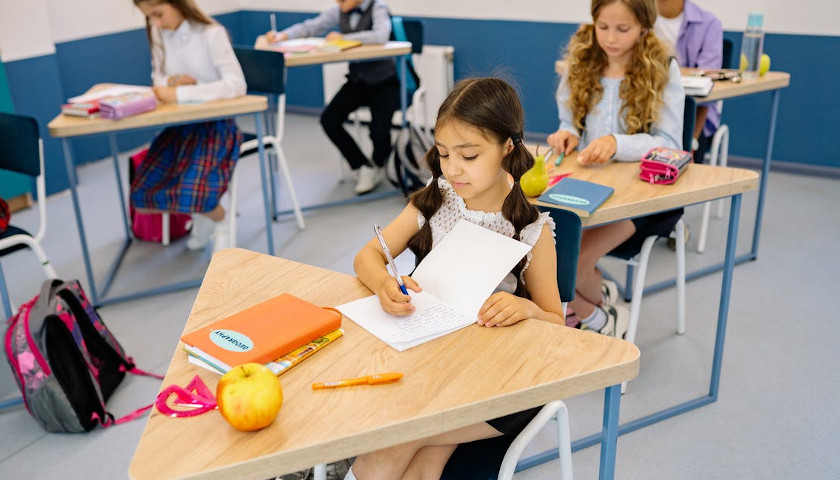“School choice is good for everybody but unions, socialist bureaucrats and the tired education establishment,” libertarian John Stossel wrote Wednesday at the New York Post.
The author and journalist observed the “silver lining” of the COVID pandemic is that parents discovered alternatives to public schools and, as the statistics are telling us, they continue to act on that discovery by removing their children from them – in droves.
New York City Mayor Eric Adams (D), for example, told angry protesters from Manhattan’s Upper West Side recently that substantial budget cuts to public schools are due to plummeting student enrollment.
“We have a massive hemorrhaging of students – massive hemorrhaging,” the mayor said, according to the New York Post. “We’re in a very dangerous place in the number of students that we are dropping.”
The nation’s largest school district expects to lose nearly 30,000 students by this fall, with another 2,300 fewer students by the end of the academic year.
Families in other urban districts are also fleeing public schools, leading to speculation about major school staff layoffs and school closures.
Former New York City Mayor Michael Bloomberg (D) says teachers’ unions were responsible for keeping schools locked down during the pandemic, a move that led to the mass exodus of students from public schools throughout the country.
Writing at Bloomberg News, the former mayor observed 1.3 million students have left government schools since the start of the pandemic in March 2020.
Criticizing the demand by teachers’ unions and their allies for even more money as student enrollments plummet and school districts lose funding, Bloomberg wrote:
Since 2020, Congress has sent an additional $190 billion to schools, in part to help them reopen safely and stave off layoffs. But in many districts, union leaders resisted a return to in-classroom instruction long after it was clear that classrooms were safe. And by and large, remote instruction was a disaster. By one analysis, the first year of the pandemic left students an average of five months behind in math and four months behind in reading, with much larger gaps for low-income schools.
“Union teachers seemed eager to be paid not to work,” Stossel noted in his column, and added:
Los Angeles teachers secured a contract that said they will “not be required to teach classes using live video conferencing” and won’t be required to “provide instruction more than four hours a day.”
“Nice work if you can get it,” he quipped.
In addition to increased enrollments in private and religious schools, Stossel noted the rise in home schooling – and its surprising value to families who had previously questioned this alternative.
“Many had been skeptical but now discovered that their kids learned more, and their family life was enriched by teaching at home,” he explained. “The education establishment sneers at home schooling, but home-schooled students, even though they are more likely to be poor, score 30 percent higher on SAT tests. They also do better in college, and they are less likely to drink or do drugs.”
Stossel noted the major opponents to school choice are the teachers’ unions, “establishment Democrats and frightened suburban Republicans.”
He sees hope, however, in the amount of innovation and education entrepreneurship that has been spurred on by the school choice movement:
One example: STOP Foundation 4 Education gives awards to educational innovators. Its $10 million will go to nonprofits, entrepreneurs and community organizations that provide more educational options. Recipients include Rock by Rock, an education-software company, and STEMuli, a game-based learning company.
With school choice, parents are finally in the driver’s seat of their children’s education.
Nationally known school choice advocate Corey A. DeAngelis explained to The Star News Network in March the fact that most Democrats vote against school choice legislation is a reflection of “power dynamics” that have little to do with “logic.”
“The logic for school choice – it’s a nonpartisan issue, especially when you think about how Democrats, in general, will support funding following the student for higher education with Pell Grants,” he noted. “And, they support funding the student when it comes to pre-K programs, including the federal Head Start program. You could take your taxpayer funding for the pre-K program to a private, religious, or non-religious provider. The funding follows the decision of the family.”
“We fund people directly when it comes to food stamps, Medicaid, Section 8 housing vouchers, and so many other taxpayer initiatives that are supported by Democrats,” DeAngelis observed. “But, only when it comes to K-12 education is there a larger amount of opposition coming from the Democrat Party.”
And that “only starts to make sense,” he said, “when you understand that there’s a difference in power dynamics, where with higher education, pre-K, and just about everything else choice is the norm, but choice threatens an entrenched special interest when it comes to K-12 education. And that special interest, the teachers’ union, of course, fights as hard as possible against change to the status quo.”
– – –
Susan Berry, PhD, is national education editor at The Star News Network. Email tips to [email protected].




